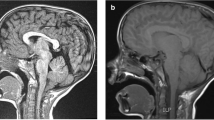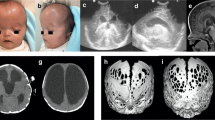Abstract
Craniometaphyseal dysplasia (CMD) is a very rare disorder of bone remodelling characterised by sclerosis of the skull base, vault and facial bones and metaphyseal splaying of tubular bones. The recessive form appears to be more severe than the dominant. Cranial nerve deficits have been reported in infancy and early childhood in a few patients, but the long-term history of recessive CMD is not well documented. We report cerebellomedullary compression in a girl with recessive CMD recognised at 14 years because of progressive truncal ataxia. MRI revealed backward angulation of the thickened clivus, narrowing of the foramen magnum and upward deviation of the cerebellum by a markedly thickened occipital squama, tonsillar herniation and obliteration of the infratentorial cerebrospinal fluid spaces. Posterior cranial fossa decompression resulted in marked improvement of the ataxia. Compression of posterior cranial fossa structures has to be considered in the natural history and management of CMD.
Similar content being viewed by others
References
McKusick VA (1992) Mendelian inheritance in man, 10th edn Johns Hopkins University Press, Baltimore
Gorlin RJ (1994) Craniotubular bone disorders. Pediatr Radiol 24: 392–406
Schroeder C, Quirin A, Oppermann HC, Oldigs HD (1992) Craniometaphysaere Dysplasie — charakteristische Roentgenbefunde. Klin Paediatr 204: 174–176
Scott RM, Wolpert SM, Pashayan HM (1983) Progressive optic nerve compression in craniometaphyseal dysplasia. In: Humphreys RP (ed) Concepts in pediatric neurosurgery, 4. Karger, Basel, pp 208–218
Puliafito CA, Wray SH, Murray JE, Boger WP (1981) Optic atrophy and visual loss in craniometaphyseal dysplasia. Am J Ophthalmol 92: 696–701
Fanconi S, Fischer JA, Wieland P, Giedion A, Boltshauser E, Olah AJ, Landolt AM, Prader A (1988) Craniometaphyseal dysplasia with increased bone turn-over and secondary hyperparathyroidism: therapeutic effect of calcitonin. J Pediatr 112: 587–591
Applegate LJ, Applegate GR, Kemp SS (1991) MR of multiple cranial neuropathies in a patient with Camurati-Engelmann disease: case report. AJNR 12: 557–559
Du Plessis JJ (1993) Sclerosteosis: neurosurgical experience with 14 cases. J Neurosurg 78: 388–392
Author information
Authors and Affiliations
Rights and permissions
About this article
Cite this article
Boltshauser, E., Schmitt, B., Wichmann, W. et al. Cerebellomedullary compression in recessive craniometaphyseal dysplasia. Neuroradiology 38 (Suppl 1), S193–S195 (1996). https://doi.org/10.1007/BF02278158
Received:
Accepted:
Issue Date:
DOI: https://doi.org/10.1007/BF02278158




